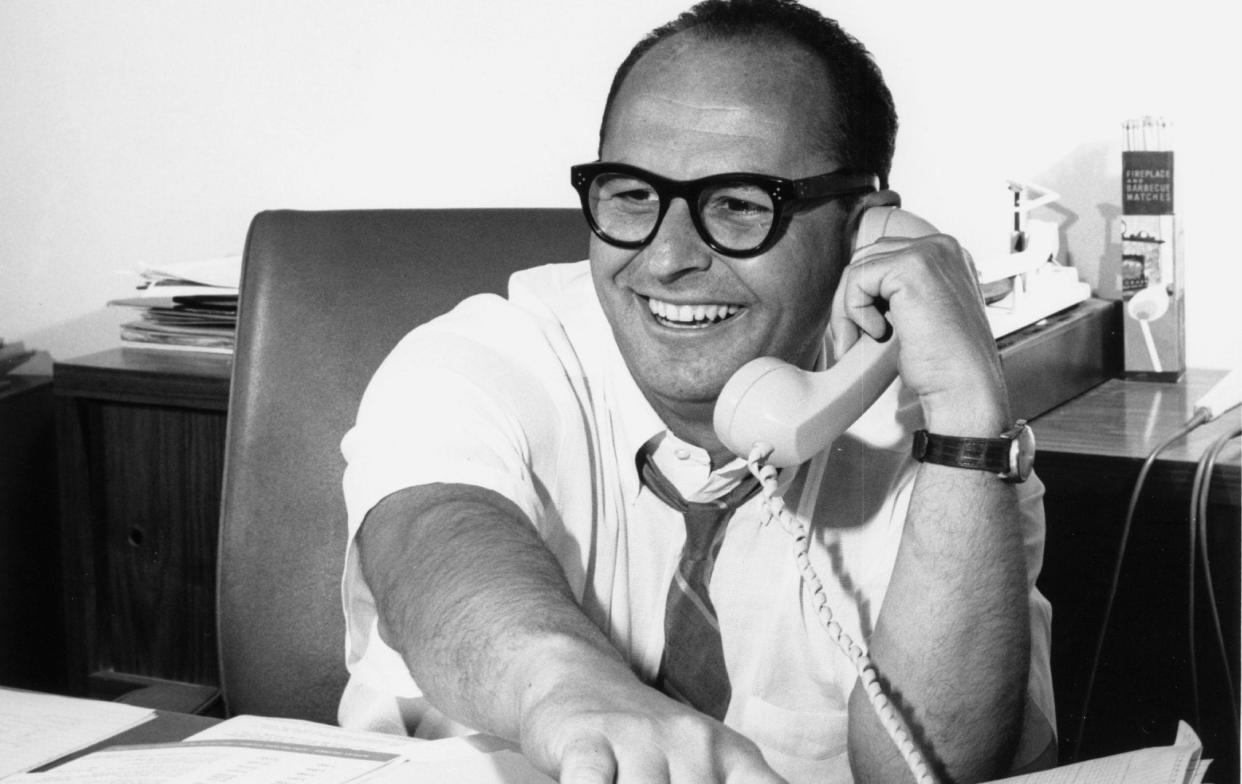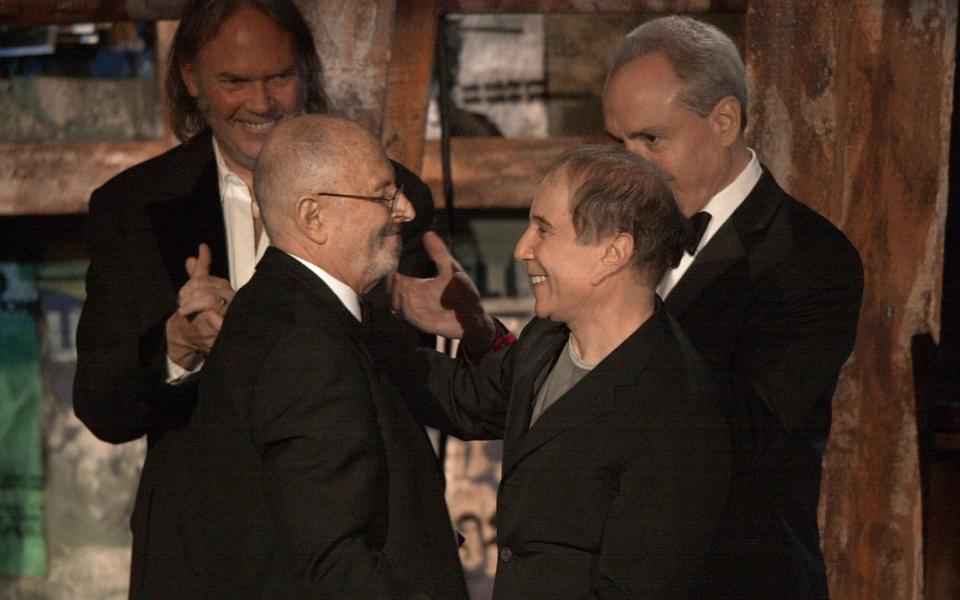Mo Ostin, music mogul who as head of Warner Records oversaw the careers of a host of appreciative rock stars – obituary

Mo Ostin, who has died aged 95, was an American record executive who as president and chairman of Warner records transformed what had been a, conservative, middle-of-the-road record label into the most significant in rock music’s golden age, and one of the biggest music businesses in America.
In the late Sixties and Seventies under Ostin’s command, Warner supported such artists as Joni Mitchell, Van Morrison, Neil Young, Fleetwood Mac and George Benson, riding successive waves of musical tastes with such artists as Prince, Van Halen and Madonna.
It was Frank Sinatra who first brought Ostin to Warner Brothers in 1963. At that time the company’s roster consisted mostly of film and stage entertainers such as Connie Stevens and Dorothy Provine, along with the comedians Bob Newhart and Alan Sherman, although it had begun to dip a tentative toe into the pop world with the Everly Brothers.
In 1963, Warner acquired Frank Sinatra’s boutique label, Reprise, as part of a deal to acquire the singer’s services as a recording artist and as an actor for Warner Bros Pictures.

The deal brought Ostin, who was then label manager for Reprise, into the Warner fold; as one observer noted, “his ultimate value to Warner Bros would dwarf Sinatra’s.”
One of the first rock acts Ostin signed to the label in 1964 was the Kinks. But it was the signing of the Grateful Dead and Jimi Hendrix that would give the label artistic credibility among a new audience of record-buyers – and a new generation of artists.
The producer and provocateur Kim Fowley, who was contracted to Reprise at the time, would later take credit for introducing Ostin to Hendrix’s music. Fowley, had been living in London at the time of Hendrix’s arrival, a complete unknown, in 1966, and been his neighbour in Bayswater.
Fowley told Ostin to “sign my neighbour”, he recounted in an interview with the journalist Harvey Kubernik.
“Why?” Ostin replied.
“Because he’s the Chuck Berry of the Sixties.”
“What does that mean?” Ostin asked.

“It means that white people will buy him,” Fowley replied. “Black people don’t buy Chuck Berry and black people won’t buy Jimi Hendrix. But a Sixties Chuck Berry would sell records to white people.”
After hearing an advance copy of Hendrix’s first single Hey Joe, Ostin flew Hendrix’s manager Mike Jefferies to Los Angeles and paid $50,000 for the guitarist’s first three albums. Other executives at Warner were aghast at paying so much money for an unknown artist.
Ostin presented Hendrix at a distributor convention, to universal bemusement: “It was not the kind of music they could relate to.” One distributor ordered just eight albums, the absolute minimum. Shortly afterwards, Hendrix appeared at the Monterey Festival, the first major gathering of the counter-culture, that would signal the emergence of rock music as a potent cultural and commercial force, setting the festival – and his guitar – on fire.
With the A&R man Lenny Waronker, whose father Sy had founded Liberty records, Ostin established what amounted to a salon of creative talents including house producers such as Ted Templeman and Russ Titelman, cultivating a roster of artists that boasted Randy Newman, Ry Cooder and Little Feat, lending Warner Bros the imprimatur of a particular savour and quality.

Ostin was also adept at creating joint-venture deals with smaller labels, which would bring artists such as Frank Zappa, Talking Heads and Depeche Mode under the Warner Bros umbrella.
Conservatively dressed, prematurely balding and sporting outsized glasses and a natty Van Dyke beard, Ostin was a modest, unassuming man who, unlike other industry titans such as Clive Davis, David Geffen and Walter Yetnikoff, shunned publicity, believing it was his artists who should be in the limelight.
“David used to beg me to do interviews,” he once told Robert Hilburn of the Los Angeles Times in a rare encounter with the media. “He’d say: ‘Mo, you’re not getting any credit. What’s the matter with you?’ Clive Davis said: ‘What, are you nuts?’ But I never allowed myself to do it.”
He cultivated almost a family atmosphere at Warner, staying loyal to high-quality artists – Randy Newman being a classic example – whom other labels might have long since discarded as commercially unviable.

Ostin once recalled that Frank Sinatra’s objective in founding Reprise had been to create an environment that would be more economically and artistically supportive to artists than any other label.
“That wasn’t how it was anywhere else,” said Ostin. “You had financial guys, lawyers, marketing guys. Their priorities may not have been the music. One of the great things about Warners, I always felt, was our emphasis and priority was always about the music.”
Mike Mills, the REM bassist, once recalled: “We knew Warner Bros actually cared about artistic integrity and if we signed with Mo we wouldn’t be pressured to sell a million copies each time out just to stay on the label.” The band had been the object of a fierce bidding war in the late Eighties. “Unlike other executives we talked to, Mo seemed genuinely interested in our music. But the best thing about him was that he seemed honest.”
Ostin could also be fiercely competitive. When Walter Yetnikoff persuaded James Taylor, a Warner artist, to leave the company and sign with Columbia, Ostin deliberately set out to woo Paul Simon, a Columbia artist, and sign him to Warner. An incensed Yetnikoff organised a protest demonstration at a Columbia convention, hiring people to wave signs saying “F--- Warner Bros.”

He was born Morris Meyer Ostrofsky on March 27 1927 in New York to immigrants who had fled Russia during the revolution (he abbreviated his name when he moved into the music business). When he was 13, the family moved to Los Angeles and opened a produce market in the predominantly Jewish Fairfax district.
Ostin was educated at Fairfax High, a school with an illustrious history of producing music-business figures, including Phil Spector, Herb Alpert and Warren Zevon, before moving on to UCLA, where he graduated in Economics.
Through a neighbour, Ostin, who was a big music fan, was introduced to Norman Granz, the jazz impresario and producer and owner of the Clef label, which recorded such artists as Oscar Peterson, Art Tatum and Count Basie, and after a brief period in law school, Ostin joined Clef as financial controller, a job that educated him in all the twists and turns of the record business.
In 1956, Granz folded Clef into a new business, Verve, which was to become the pre-eminent jazz label in America.

Disgruntled with his recording contract with Capitol, Frank Sinatra, an avid jazz fan, attempted to buy Verve, but was thwarted when the company was taken over by MGM. Instead, Sinatra set up Reprise, taking Ostin to run the label on a salary of $500 a week. “I was so excited about it,” Ostin recalled, “that when I finally closed the deal, my wife and I ran out and bought a house in Encino.”
In 1995, Ostin left Warner Bros following a disagreement with the parent company Time Warner over his loyalty to long-standing artists and employees, and amid criticisms in the music industry trades that the company had lost its way.
He went on to join the music division of the entertainment conglomerate DreamWorks SKG, which had been founded by Steven Spielberg, Jeffrey Katzenberg and Ostin’s long-time business rival David Geffen.
In 1984, Geffen, engrossed in one of the combative business deals he seemed to relish, was attempting to get Warner Bros to relinquish a 50 per cent share in his company Geffen Records. Realising that Ostin, a notoriously astute negotiator, would never agree to the deal, Geffen set out to deliberately antagonise Ostin so that he could deal directly with Steve Ross, the chairman of Warner Communications, whom he believed would be more persuadable.

By the account of Geffen’s biographer Tom King, Geffen was friends with Ostin’s wife Evelyn, and over lunch one day, in order to provoke her, he deliberately began to sow the seeds of doubt about Ostin’s marriage. “You know Mo doesn’t really care about you that much,” he told her. “David,” a shocked Evelyn replied, “This is the man I’ve been married to for 34 years!”
She and Ostin were so outraged they did not speak to Geffen for a year. Geffen did the deal with Ross, to the astonishment of Ostin. “Now is the time to buy Geffen Records,” he admonished Ross, “it’s not the time to give it up for nothing.”
Geffen and Ostin later made up after Geffen apologised, but without ever telling Ostin about his motives. Geffen also made up with Evelyn – later making what King described as the “ultimate Hollywood sacrifice, relinquishing one of his weekly sessions with his therapist and giving it to Evelyn”.
At DreamWorks Ostin cultivated the careers of a new generation of artists, including Rufus Wainwright and Nelly Furtado, along with veterans like the Isley Brothers and Burt Bacharach.

In 2003 he was inducted into the Rock and Roll Hall of Fame. The following year he retired from the music industry after the DreamWorks label was sold to Universal Music Group, but he continued to do consulting work for Warners.
Ostin was a collector of art, with a particular passion for Picasso, whose work he had been introduced to by the jazz producer and promoter Norman Granz, who knew the artist personally. He once talked of how one of his greatest regrets was not signing Picasso to Warners after a business associate had persuaded the artist to do an animated film on Don Quixote. Under the deal, Ostin would have got the soundtrack.
“We even had a hand-written contract with Picasso saying he was going to do it for $100,000 against 10 per cent of the gross,” he recalled. “This was revolutionary.” But the project was aborted after the film studios deemed it too risky. “How could they pass up the chance to be involved with one of the true geniuses of the 20th century?” said Ostin. “It was just incomprehensible to me. I mean, where were these guys at?”
His wife Evelyn died in 2005, and Mo Ostin is survived by a son. Two of his sons predeceased him, in 2004 and 2013.
Mo Ostin, born March 27 1927, died July 31 2022

 Yahoo News
Yahoo News 
